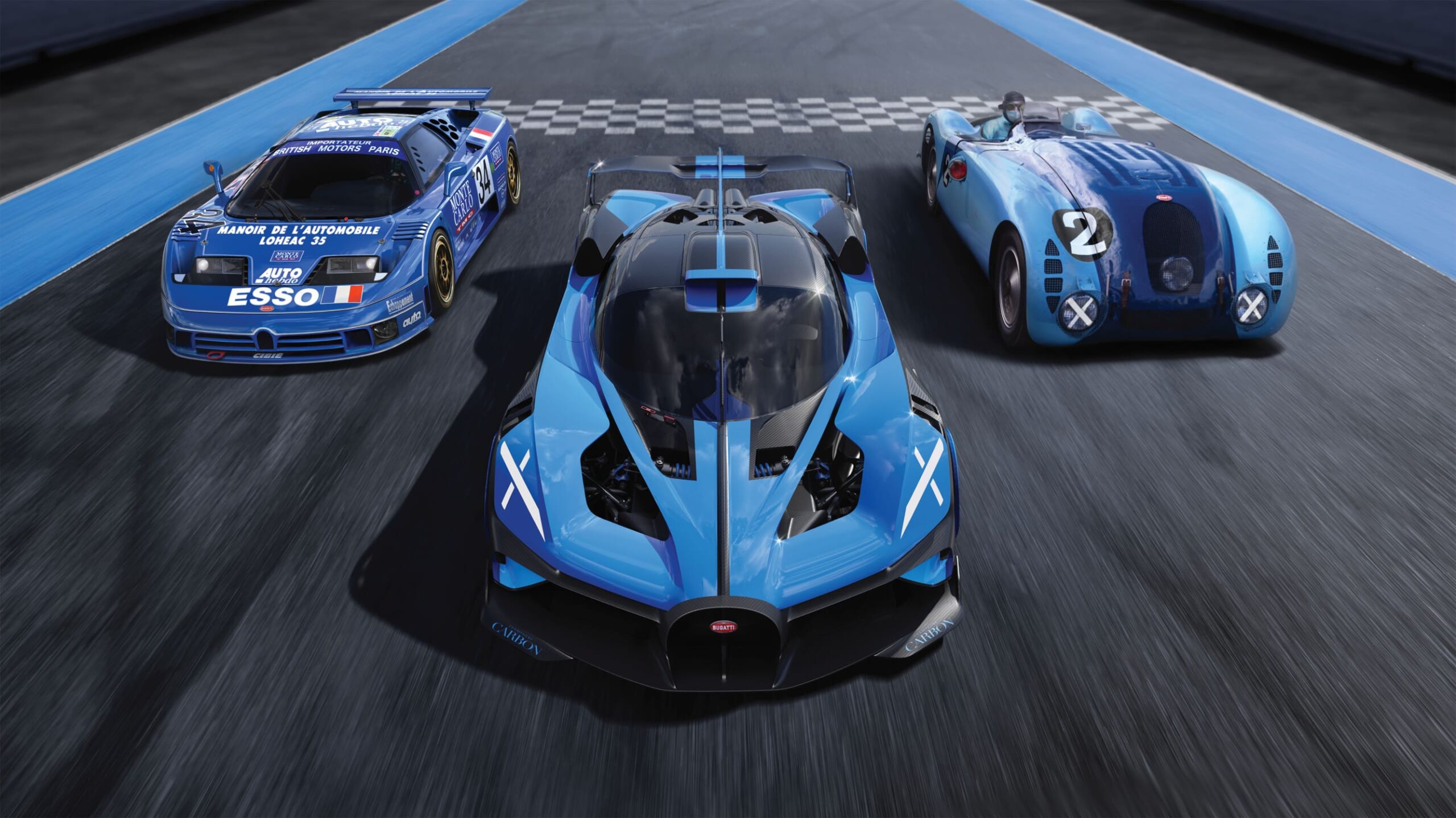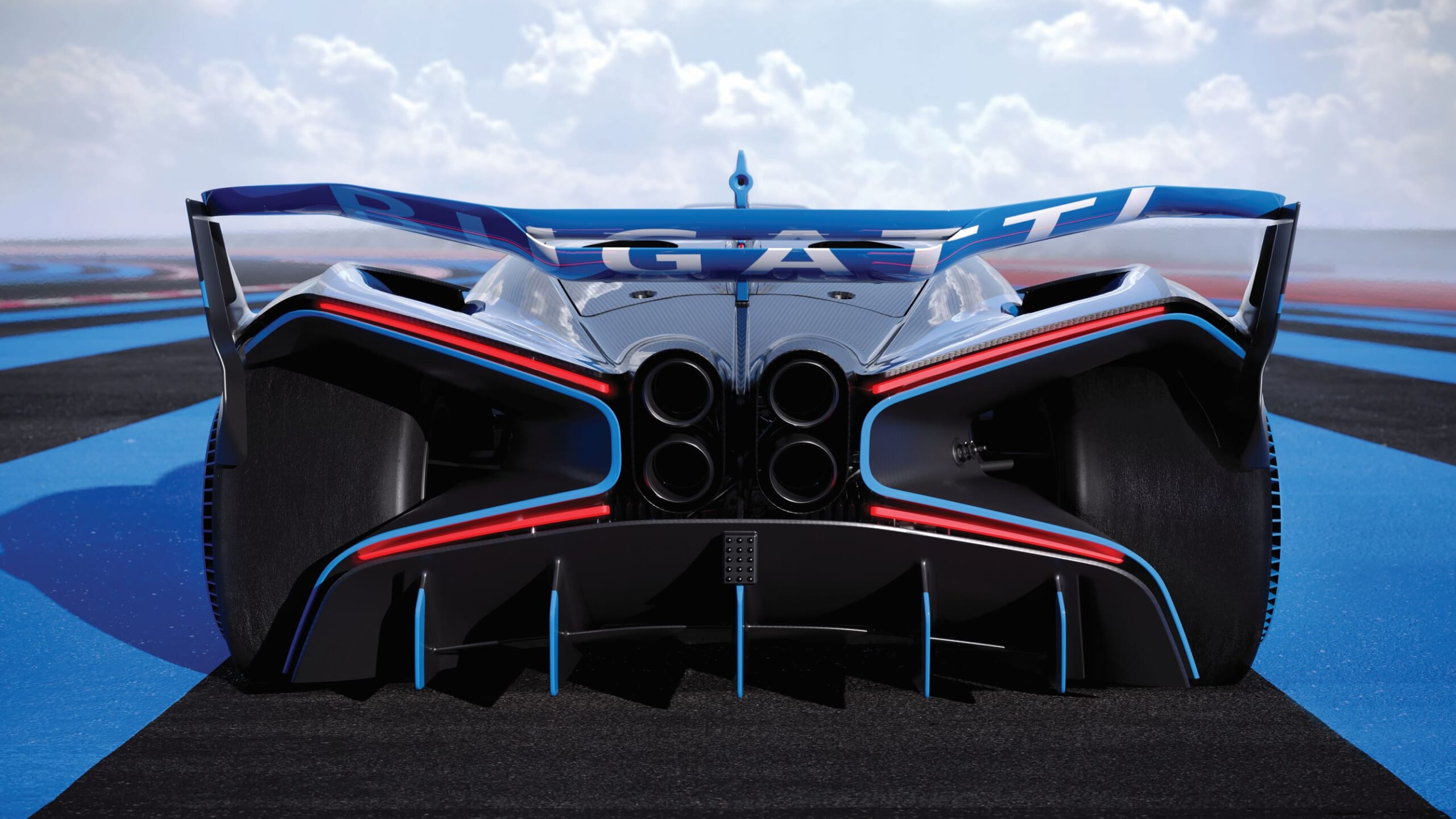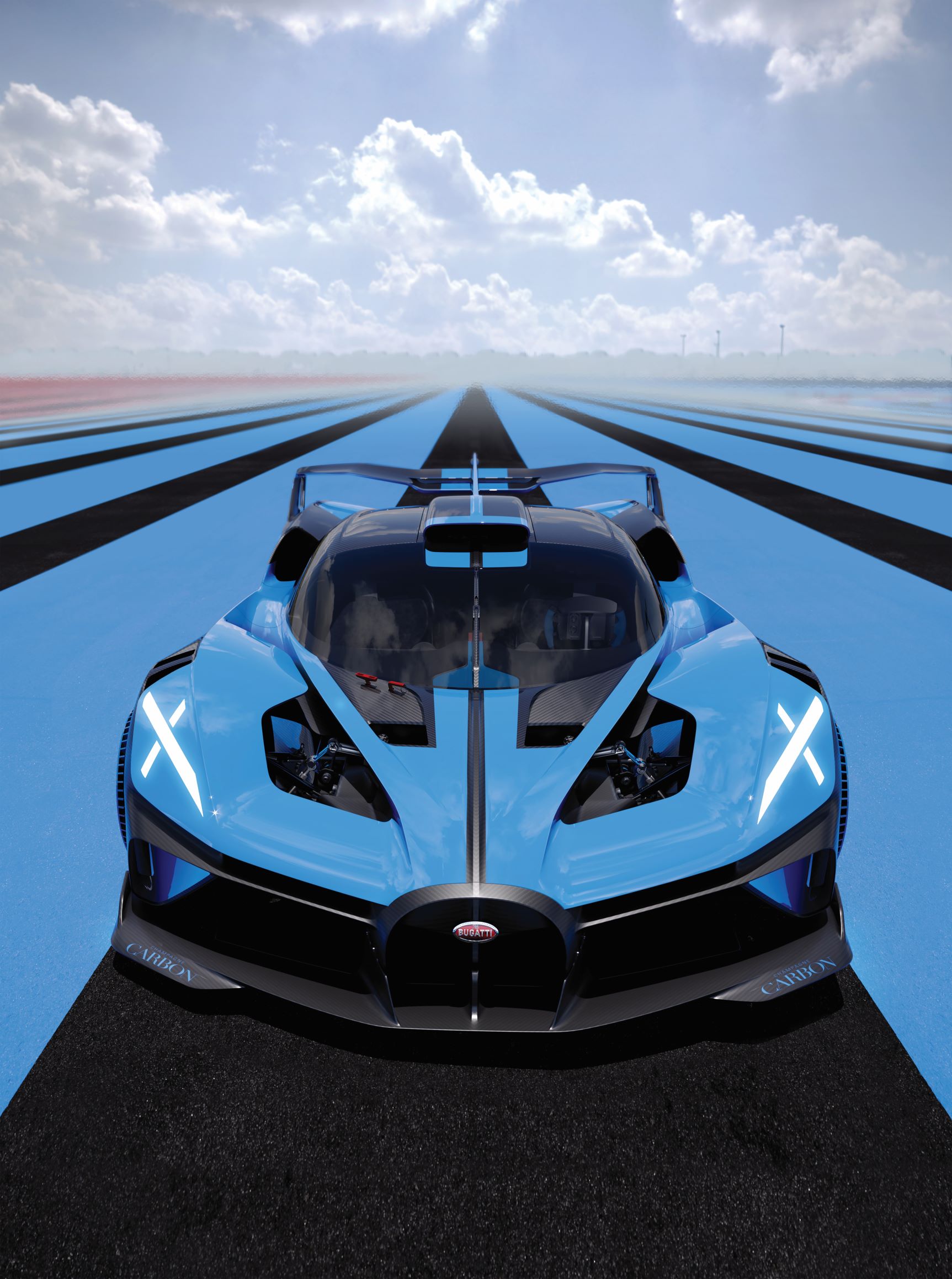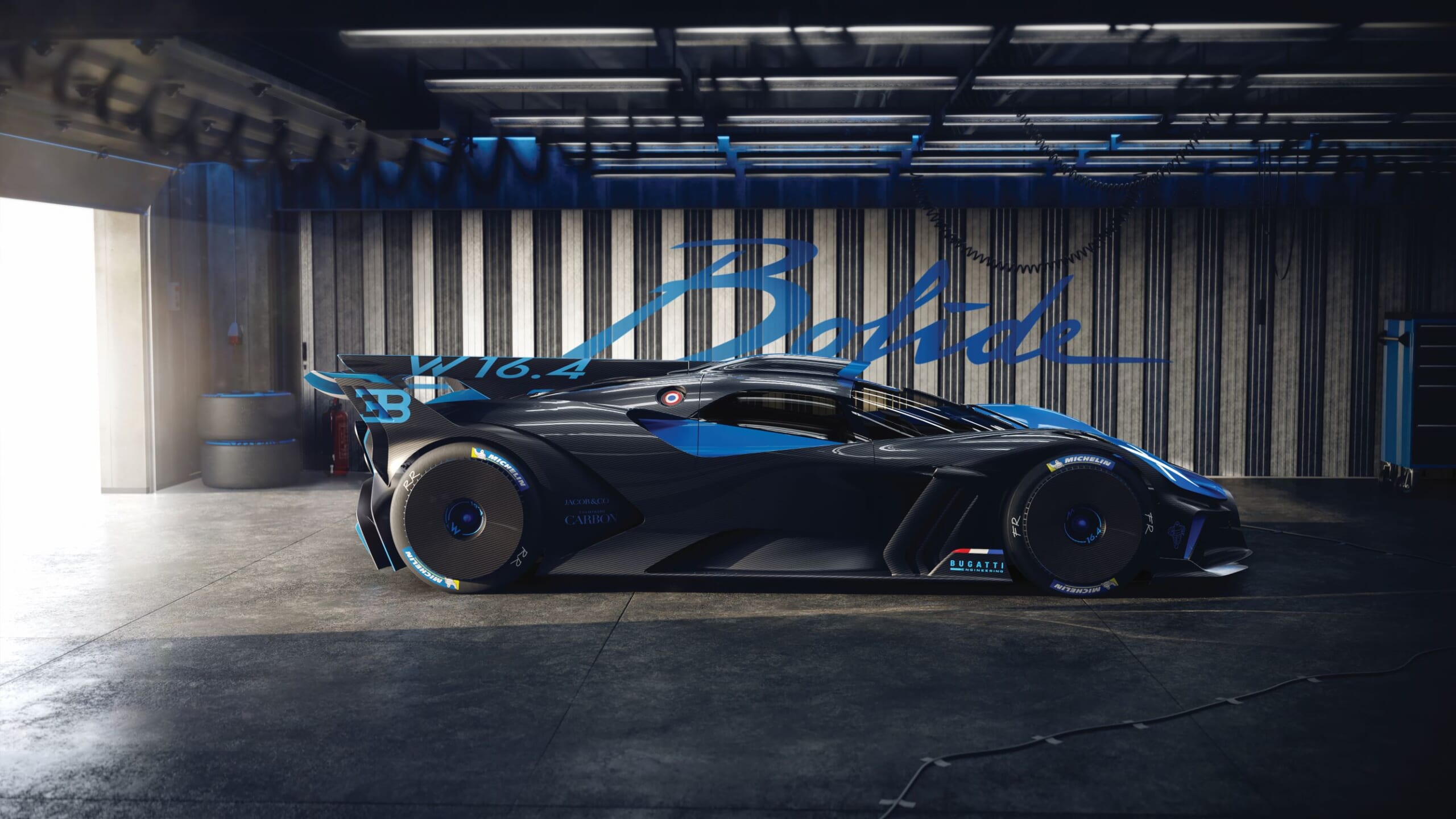How the Bugatti Bolide Blasts Way Past 300 MPH
Built around the mythical 8.0-liter 16-cylinder engine, this insane track-only hypercar is the lightest Bugatti ever made.

A couple of years ago we visited the hallowed ground of the Château St. Jean in Molsheim, France. This plot of grassy earth is home not only to one of the most elegant mansions we’ve ever set foot in, it is also the holy land for automotive truth-seekers—the house which Italian furniture and jewelry designer Carlo Bugatti built in 1856 for his family, in what was then part of Germany. Ground zero for Bugatti lore, the place where Carlo’s son Ettore, one of the greatest minds in automotive history, would go on to design, engineer and build the fastest cars the planet had ever seen from 1909 to 1939.
That visit was to witness the first example of Bugatti’s latest street-legal production car, the Chiron, be built and personalized. Now the French marque has lifted the veil on the craziest, fastest, most obscene track-focused version of the Chiron to date: the aptly named Bolide, meaning fireball, or an “extremely bright meteor that explodes in the atmosphere.”
“Bugatti never stands still,” vows the always sharply-dressed President of the iconic company, Stephan Winkelmann. “We are perpetually aiming for new and exciting goals, and the question that we always keep in mind is: what if?”

Built around the mythical 8.0-liter 16-cylinder engine that has been the heart of every Bugatti since the brand relaunched production in 2005, the Bolide is the final solution to the challenge of producing the radically lightest Bugatti hypercar possible—one with a weight-topower ratio more on par with a Formula One car than anything that has come before it. “Driving the Bolide,” Winkelmann notes, “is like riding on a cannonball.”
To say Bugatti is the most luxurious automotive badge on the planet is no hyperbole. Because they marry the remarkable bespoke attention and customization of the Koenigseggs, Singers and Paganis of the world—badges that annually handcraft single-digit units with keen attention to detail and personalization—with the munificent capital and pulsing brainpower of arguably the most advanced automotive conglomerate on the planet, the VW Group.
Then there’s that W16, the most powerful internal combustion engine on Earth, (tweaked for 1,825-horsepower in the Bolide), and opulent materials and artisanal craftsmanship equaled only by the bespoke Bentleys and Rolls-Royces of the world.
On one hand, from their French château, Bugatti tailor-design and build godlike hypercars, with the ability to match a paint job to the color of a child’s iris; and on the other they can draw upon the coffers, engineering skills and patents of an international conglomerate that holds Lamborghini, Porsche, Audi and the aforementioned Bentley under its umbrella. The combination is singular in the automotive landscape.

Bugatti tapped this engineering largesse to achieve the Bolide. To paraphrase motorsport legend and Lotus founder Colin Chapman, to create a great racing machine one must simplify, and add lightness. This is a theory Bugatti engineers drove to terminal lengths to achieve the Bolide’s Kate Moss-like dry weight of 2,734-pounds. This diet was primarily driven by innovations in materials and production processes beginning with 100% titanium screws and fastening elements, and other aerospace-grade titanium alloy components.
Another material innovation was combining high-strength and ultra-stiff carbon fiber with hollow 3D-printed titanium—the high-strength metal’s ultra-thin walls as slim as 0.5-mm thick. This hybrid tech didn’t come from the paddocks of F1, but was pioneered by Bugatti itself. “To do things differently than others is nothing new to Bugatti,” Frank Götzke, Bugatti’s Head of New Technologies, tell us, “as the brand stands for the continuous quest for technological innovations and has always paved the way for others.”
Other engineering tricks include developing four new turbochargers outfitted with optimized blades that accelerate boost pressure and power at higher engine speeds. The outer skin of the roof ’s intake scoop is morphable, meaning when driven at a slow speed the scoop remains smooth, but at speed the surface bulges with bubbles to reduce aerodynamic drag and lift. They claim this active airflow is a worldwide innovation. And the Bolide’s exterior styling is a radical nexus of air ducts, grilles and swooping shapes whose open fascia hints more at an F1 racer than the Chiron.
“It is the very first time that my team had the freedom of creating an absolutely minimalistic design around the W16 engine,” shares Bugatti’s Director of Design Achim Anscheidt. “The result is the most provocative proportion of a modern Bugatti ever, and the distilled quintessence of our Bugatti design ethos that form follows performance. The Bugatti Bolide, however, is a project more technically driven than shaped by style.”

Aiming to keep the driver as low as possible, and factoring in the seats’ architecture, steering wheel angle, positioning of the airscoop and the necessary room for helmets, the Bolide measures only 39 inches tall—almost a foot shorter than the already squat Chiron, and exactly the same height as Bugatti’s watershed Type 35—with over 2,000 victories to its name, the winningest race car in motorsports history.
Was this exact height a goal the Design Chief and his team specifically aimed for, as an homage to the legendary Type 35? “It was a happy coincidence,” asserts Anscheidt, “which we are really happy with.”
Perhaps the Bolide’s most salient design cues are the “X” shapes sprinkled throughout the car, most prominently in the dramatic rear-light execution wrought in long LEDs. Branching out from the quad exhaust pipes, the design makes the Bolide look less like a real-world race car and more like a fantasy vehicle the X-Men might drive.
As dramatic as the rear is, however, Anscheidt explains it is just another example of form follows performance: “Everything designed at this rear end is devoted to the aerodynamic flow. Under no circumstances did we want to have any kind of additional taillight interfering with that airflow. As a consequence we envisioned those four rays of light stripes exactly embedded into the remaining edges because there they are not obstructing any kind of airflow.”
Once they recognized this X shape, designers began to find ways to repeat the graphic across the Bolide, lending it a cohesive visual identity. “But it came secondary, first there really was the performance and aerodynamic aspect only,” Anscheidt promises. “The Bugatti Bolide is an absolute rebel. It is clear to see that its only aim is to convey the pure power of the W16 engine in a visually and technically unadulterated form—reduced, raw, and authentic.”






